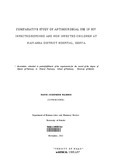| dc.description.abstract | Background: Antimicrobial use in HIV exposed and infected children aged b~low 5 years is a very frequent occurrence in clinical practice. However, frequent, nnwarranted, and inappropriate use of these drugs has been on the rise bringing about issues of worldwide concern which include drug resistance. There are limited studies which show differences in antimicrobial prescribing patterns among different populations and hence the basis of a comparative study.
Objective of the. study: The objective of the study was to compare antimicrobial prescribing patterns between HIV exposed/infected and HIV negative. patients.
Eligibility Criteria: HIV. exposed/infected and HIV negative children aged below. 5 years attending Naivasha District Hospital during the study period were eligible for the study.
Methodology: The study was a hospital based cross sectional survey. It was divided into two parts: comparative survey of prescribing patterns and in-depth interview with prescribers. Data was collected on .antimicrobials prescribed between 1st June and 30th July 2012. The antibiotic. choice, dosing and frequency was determined from the World Health Organization guidelines and compared to the prescribed drugs and dosages to determine appropriateness of use.
Quantitative data was analyzed using SPSS version 18.0 software; comparative chi-square test was done. Qualitative data was also analyzed, themes were mapped and content analysis done.
Justification: The World Health Organization cites significant existing gaps in the evidence for management of pneumonia, diarrhoea and other acute and opportunistic infections in HIV- infected/exposed infants and children. The study sought to identify existing differences in the management of these common childliood diseases, hence, the results will aid in the formulation . of clinical practice interventions in order to improve therapy and outcomes in the study setting.Results: The study found an existing difference in the prescribing pattern of antibiotics between HIV exposed/infected and non HIV infected children. There were 12 antibiotics prescribed to the HIV non infected children; a much wider range as compared to only 3 th>es of antibiotics prescribed HIV exposed/infected patients. The first .3 most commonly prescribed antibiotics in both clinical settings were cotrimoxazole, amoxicillin and ampicillin/cloxaciflin. Only 20.5% of the antibiotic prescriptions in POPC complied with the WHO guidelines. Prescriptions of HIV exposed patients were 90 times more likely to comply to the guidelines OR 90.3 95% CI: (36.4- 223.8). HIV infected patients had the prescriptions with the highest occurrence of errors with the wrong frequency and duration. Lower Cadres of health workers were associated with more than 80% of the prescriptions that did not comply with the guidelines.
Conclusion: Prescriptions for HIV exposed/infected children were more likely to comply 'with . the World Health Organization Guidelines for choice of antibiotics compared to the HIV non infected children. However, HIV exposed/infected children were also more likely to receive antibiotic prescriptions with' the wrong dose. This could significantly lead to ineffective prophylaxis and management of opportunistic infections. Amoxicillin was the most commonly
prescribed antibiotic and also the most irrationally prescribed in both clinical settings. This was mostly associated with the lower cadres of health workers. | en_US |

